Van-Dinh Nguyen
SHeRL-FL: When Representation Learning Meets Split Learning in Hierarchical Federated Learning
Aug 11, 2025
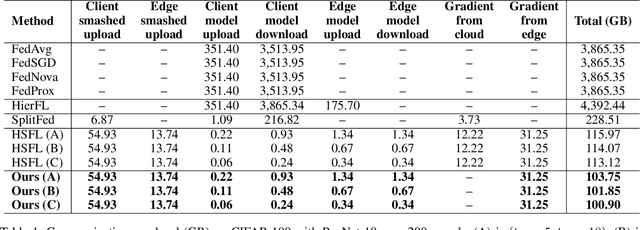
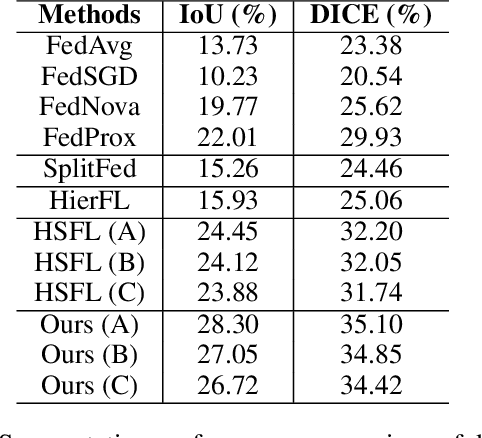
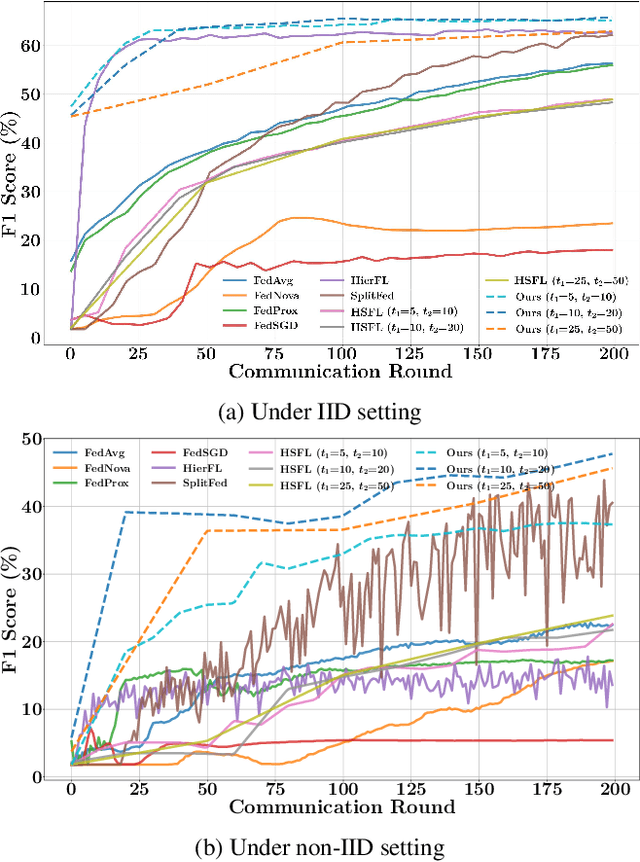
Abstract:Federated learning (FL) is a promising approach for addressing scalability and latency issues in large-scale networks by enabling collaborative model training without requiring the sharing of raw data. However, existing FL frameworks often overlook the computational heterogeneity of edge clients and the growing training burden on resource-limited devices. However, FL suffers from high communication costs and complex model aggregation, especially with large models. Previous works combine split learning (SL) and hierarchical FL (HierFL) to reduce device-side computation and improve scalability, but this introduces training complexity due to coordination across tiers. To address these issues, we propose SHeRL-FL, which integrates SL and hierarchical model aggregation and incorporates representation learning at intermediate layers. By allowing clients and edge servers to compute training objectives independently of the cloud, SHeRL-FL significantly reduces both coordination complexity and communication overhead. To evaluate the effectiveness and efficiency of SHeRL-FL, we performed experiments on image classification tasks using CIFAR-10, CIFAR-100, and HAM10000 with AlexNet, ResNet-18, and ResNet-50 in both IID and non-IID settings. In addition, we evaluate performance on image segmentation tasks using the ISIC-2018 dataset with a ResNet-50-based U-Net. Experimental results demonstrate that SHeRL-FL reduces data transmission by over 90\% compared to centralized FL and HierFL, and by 50\% compared to SplitFed, which is a hybrid of FL and SL, and further improves hierarchical split learning methods.
"Security for Everyone" in Finite Blocklength IRS-aided Systems With Perfect and Imperfect CSI
Apr 07, 2025Abstract:Provisioning secrecy for all users, given the heterogeneity in their channel conditions, locations, and the unknown location of the attacker/eavesdropper, is challenging and not always feasible. The problem is even more difficult under finite blocklength constraints that are popular in ultra-reliable low-latency communication (URLLC) and massive machine-type communications (mMTC). This work takes the first step to guarantee secrecy for all URLLC/mMTC users in the finite blocklength regime (FBR) where intelligent reflecting surfaces (IRS) are used to enhance legitimate users' reception and thwart the potential eavesdropper (Eve) from intercepting. To that end, we aim to maximize the minimum secrecy rate (SR) among all users by jointly optimizing the transmitter's beamforming and IRS's passive reflective elements (PREs) under the FBR latency constraints. The resulting optimization problem is non-convex and even more complicated under imperfect channel state information (CSI). To tackle it, we linearize the objective function, and decompose the problem into sequential subproblems. When perfect CSI is not available, we use the successive convex approximation (SCA) approach to transform imperfect CSI-related semi-infinite constraints into finite linear matrix inequalities (LMI).
Energy-Aware Resource Allocation for Energy Harvesting Powered Wireless Sensor Nodes
Jan 11, 2025Abstract:Low harvested energy poses a significant challenge to sustaining continuous communication in energy harvesting (EH)-powered wireless sensor networks. This is mainly due to intermittent and limited power availability from radio frequency signals. In this paper, we introduce a novel energy-aware resource allocation problem aimed at enabling the asynchronous accumulate-then-transmit protocol, offering an alternative to the extensively studied harvest-then-transmit approach. Specifically, we jointly optimize power allocation and time fraction dedicated to EH to maximize the average long-term system throughput, accounting for both data and energy queue lengths. By leveraging inner approximation and network utility maximization techniques, we develop a simple yet efficient iterative algorithm that guarantees at least a local optimum and achieves long-term utility improvement. Numerical results highlight the proposed approach's effectiveness in terms of both queue length and sustained system throughput.
Performance Analysis and Power Allocation for Massive MIMO ISAC Systems
Nov 16, 2024



Abstract:Integrated sensing and communications (ISAC) is envisioned as a key feature in future wireless communications networks. Its integration with massive multiple-input-multiple-output (MIMO) techniques promises to leverage substantial spatial beamforming gains for both functionalities. In this work, we consider a massive MIMO-ISAC system employing a uniform planar array with zero-forcing and maximum-ratio downlink transmission schemes combined with monostatic radar-type sensing. Our focus lies on deriving closed-form expressions for the achievable communications rate and the Cram\'er--Rao lower bound (CRLB), which serve as performance metrics for communications and sensing operations, respectively. The expressions enable us to investigate important operational characteristics of massive MIMO-ISAC, including the mutual effects of communications and sensing as well as the advantages stemming from using a very large antenna array for each functionality. Furthermore, we devise a power allocation strategy based on successive convex approximation to maximize the communications rate while guaranteeing the CRLB constraints and transmit power budget. Extensive numerical results are presented to validate our theoretical analyses and demonstrate the efficiency of the proposed power allocation approach.
HierSFL: Local Differential Privacy-aided Split Federated Learning in Mobile Edge Computing
Jan 16, 2024Abstract:Federated Learning is a promising approach for learning from user data while preserving data privacy. However, the high requirements of the model training process make it difficult for clients with limited memory or bandwidth to participate. To tackle this problem, Split Federated Learning is utilized, where clients upload their intermediate model training outcomes to a cloud server for collaborative server-client model training. This methodology facilitates resource-constrained clients' participation in model training but also increases the training time and communication overhead. To overcome these limitations, we propose a novel algorithm, called Hierarchical Split Federated Learning (HierSFL), that amalgamates models at the edge and cloud phases, presenting qualitative directives for determining the best aggregation timeframes to reduce computation and communication expenses. By implementing local differential privacy at the client and edge server levels, we enhance privacy during local model parameter updates. Our experiments using CIFAR-10 and MNIST datasets show that HierSFL outperforms standard FL approaches with better training accuracy, training time, and communication-computing trade-offs. HierSFL offers a promising solution to mobile edge computing's challenges, ultimately leading to faster content delivery and improved mobile service quality.
Securing MIMO Wiretap Channel with Learning-Based Friendly Jamming under Imperfect CSI
Dec 12, 2023



Abstract:Wireless communications are particularly vulnerable to eavesdropping attacks due to their broadcast nature. To effectively deal with eavesdroppers, existing security techniques usually require accurate channel state information (CSI), e.g., for friendly jamming (FJ), and/or additional computing resources at transceivers, e.g., cryptography-based solutions, which unfortunately may not be feasible in practice. This challenge is even more acute in low-end IoT devices. We thus introduce a novel deep learning-based FJ framework that can effectively defeat eavesdropping attacks with imperfect CSI and even without CSI of legitimate channels. In particular, we first develop an autoencoder-based communication architecture with FJ, namely AEFJ, to jointly maximize the secrecy rate and minimize the block error rate at the receiver without requiring perfect CSI of the legitimate channels. In addition, to deal with the case without CSI, we leverage the mutual information neural estimation (MINE) concept and design a MINE-based FJ scheme that can achieve comparable security performance to the conventional FJ methods that require perfect CSI. Extensive simulations in a multiple-input multiple-output (MIMO) system demonstrate that our proposed solution can effectively deal with eavesdropping attacks in various settings. Moreover, the proposed framework can seamlessly integrate MIMO security and detection tasks into a unified end-to-end learning process. This integrated approach can significantly maximize the throughput and minimize the block error rate, offering a good solution for enhancing communication security in wireless communication systems.
Fairness Enhancement of UAV Systems with Hybrid Active-Passive RIS
Jun 24, 2023Abstract:We consider unmanned aerial vehicle (UAV)-enabled wireless systems where downlink communications between a multi-antenna UAV and multiple users are assisted by a hybrid active-passive reconfigurable intelligent surface (RIS). We aim at a fairness design of two typical UAV-enabled networks, namely the static-UAV network where the UAV is deployed at a fixed location to serve all users at the same time, and the mobile-UAV network which employs the time division multiple access protocol. In both networks, our goal is to maximize the minimum rate among users through jointly optimizing the UAV's location/trajectory, transmit beamformer, and RIS coefficients. The resulting problems are highly nonconvex due to a strong coupling between the involved variables. We develop efficient algorithms based on block coordinate ascend and successive convex approximation to effectively solve these problems in an iterative manner. In particular, in the optimization of the mobile-UAV network, closed-form solutions to the transmit beamformer and RIS passive coefficients are derived. Numerical results show that a hybrid RIS equipped with only 4 active elements and a power budget of 0 dBm offers an improvement of 38%-63% in minimum rate, while that achieved by a passive RIS is only about 15%, with the same total number of elements.
Joint Communications and Sensing Design for Multi-Carrier MIMO Systems
Jun 24, 2023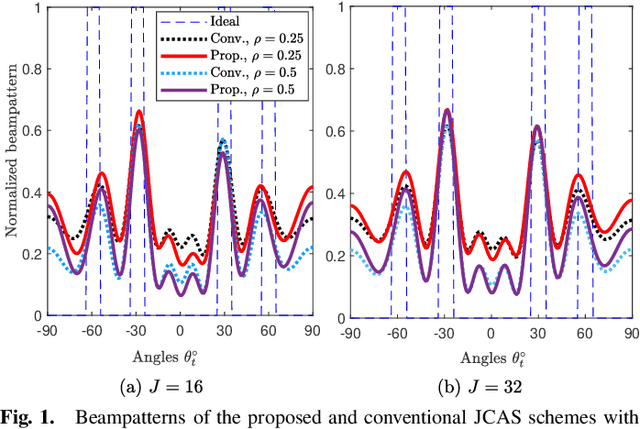
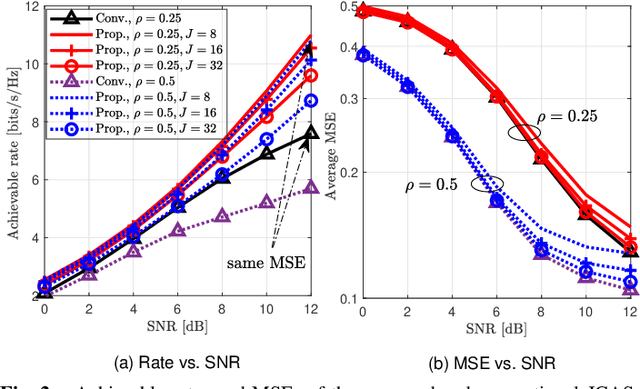
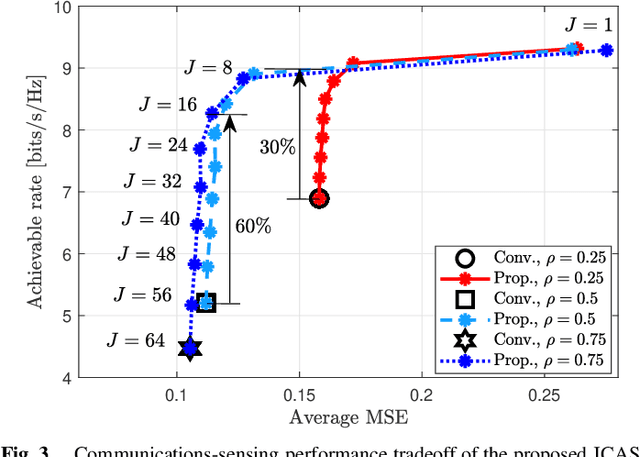
Abstract:In conventional joint communications and sensing (JCAS) designs for multi-carrier multiple-input multiple-output (MIMO) systems, the dual-functional waveforms are often optimized for the whole frequency band, resulting in limited communications--sensing performance tradeoff. To overcome the limitation, we propose employing a subset of subcarriers for JCAS, while the communications function is performed over all the subcarriers. This offers more degrees of freedom to enhance the communications performance under a given sensing accuracy. We first formulate the rate maximization under the sensing accuracy constraint to optimize the beamformers and JCAS subcarriers. The problem is solved via Riemannian manifold optimization and closed-form solutions. Numerical results for an 8x4 MIMO system with 64 subcarriers show that compared to the conventional subcarrier sharing scheme, the proposed scheme employing 16 JCAS subcarriers offers 60% improvement in the achievable communications rate at the signal-to-noise ratio of 10 dB. Meanwhile, this scheme generates the sensing beampattern with the same quality as the conventional JCAS design.
Network-Aided Intelligent Traffic Steering in 6G ORAN: A Multi-Layer Optimization Framework
Feb 06, 2023Abstract:To enable an intelligent, programmable and multi-vendor radio access network (RAN) for 6G networks, considerable efforts have been made in standardization and development of open RAN (ORAN). So far, however, the applicability of ORAN in controlling and optimizing RAN functions has not been widely investigated. In this paper, we jointly optimize the flow-split distribution, congestion control and scheduling (JFCS) to enable an intelligent traffic steering application in ORAN. Combining tools from network utility maximization and stochastic optimization, we introduce a multi-layer optimization framework that provides fast convergence, long-term utility-optimality and significant delay reduction compared to the state-of-the-art and baseline RAN approaches. Our main contributions are three-fold: i) we propose the novel JFCS framework to efficiently and adaptively direct traffic to appropriate radio units; ii) we develop low-complexity algorithms based on the reinforcement learning, inner approximation and bisection search methods to effectively solve the JFCS problem in different time scales; and iii) the rigorous theoretical performance results are analyzed to show that there exists a scaling factor to improve the tradeoff between delay and utility-optimization. Collectively, the insights in this work will open the door towards fully automated networks with enhanced control and flexibility. Numerical results are provided to demonstrate the effectiveness of the proposed algorithms in terms of the convergence rate, long-term utility-optimality and delay reduction.
Edge Computing for Semantic Communication Enabled Metaverse: An Incentive Mechanism Design
Dec 13, 2022Abstract:Semantic communication (SemCom) and edge computing are two disruptive solutions to address emerging requirements of huge data communication, bandwidth efficiency and low latency data processing in Metaverse. However, edge computing resources are often provided by computing service providers and thus it is essential to design appealingly incentive mechanisms for the provision of limited resources. Deep learning (DL)- based auction has recently proposed as an incentive mechanism that maximizes the revenue while holding important economic properties, i.e., individual rationality and incentive compatibility. Therefore, in this work, we introduce the design of the DLbased auction for the computing resource allocation in SemComenabled Metaverse. First, we briefly introduce the fundamentals and challenges of Metaverse. Second, we present the preliminaries of SemCom and edge computing. Third, we review various incentive mechanisms for edge computing resource trading. Fourth, we present the design of the DL-based auction for edge resource allocation in SemCom-enabled Metaverse. Simulation results demonstrate that the DL-based auction improves the revenue while nearly satisfying the individual rationality and incentive compatibility constraints.
 Add to Chrome
Add to Chrome Add to Firefox
Add to Firefox Add to Edge
Add to Edge